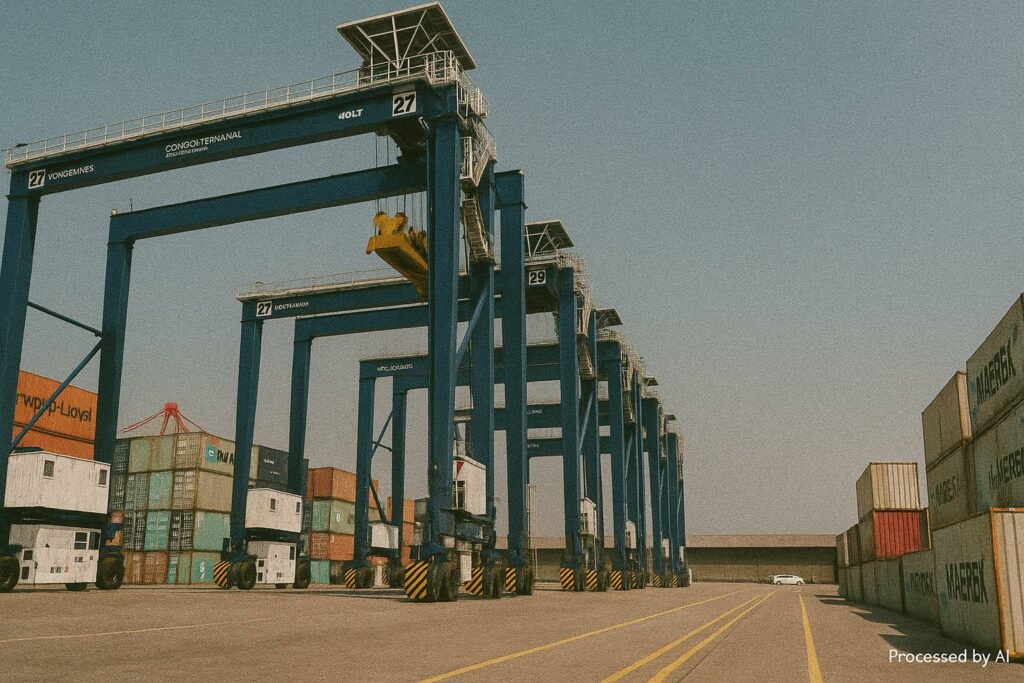A Quiet Arrival with Loud Implications
When the last of seven rubber-tyred gantry cranes rolled off the vessel into the yards of Congo Terminal on 31 July 2025, no ribbon-cutting ceremony was broadcast on continental television. Yet, for shipping lines recalibrating their West African rotations, the discreet arrival signalled a logistical leap of rare magnitude. With a lifting capacity of forty tonnes, the new machines can stack containers five stories high across seven rows, a specification that effectively rewrites the port’s spatial arithmetic and anticipates a new generation of 366-metre vessels already testing Atlantic drafts.
Port operators across the Gulf of Guinea have been investing aggressively, but Pointe-Noire holds a geographic trump card: it is the only natural deep-sea harbour between Luanda and Walvis Bay capable of handling post-Panamax ships without extensive dredging. By reinforcing that comparative advantage, the terminal’s parent company, Africa Global Logistics (AGL), is placing a calculated wager on the durability of Central Africa’s trade rebound (AGL press release, 3 Aug 2025).
Operational Metrics and the Pursuit of Fluidity
Congo Terminal’s management insists that the new equipment will shrink dwell times in the yard by a quarter and raise berth productivity above forty moves per hour—figures that, if sustained, would place Pointe-Noire among the most efficient sub-Saharan container gateways, alongside Durban and Mombasa. The port’s existing toolkit now encompasses eight ship-to-shore gantries, thirty-three RTGs, five mobile harbour cranes and eleven reach-stackers, a constellation calibrated to reach 2.4 million twenty-foot equivalent units (TEUs) annually by 2027.
Those projections rest on robust empirical trends. Data from UNCTAD show that Central African container volumes have expanded by an average of 6.8 percent annually since 2019, outpacing global growth rates (UNCTAD, 2024). Meanwhile, the World Bank’s Logistics Performance Index records a steady narrowing of the infrastructure gap between the sub-region and the continental average (World Bank, 2023). Against that backdrop, Pointe-Noire’s window for scaling up appears both urgent and commercially rational.
Human Capital: Beyond the Machinery
Each RTG requires a three-shift relay of skilled operators, electricians and maintenance engineers. Management has therefore launched a recruitment and training programme that will bring an additional ninety Congolese technicians onto the payroll, supplementing the existing workforce of nearly nine hundred. In partnership with the National Institute of Transport and Logistics, simulator-based modules have been introduced to compress learning curves without disrupting live operations, a model long practised in Singapore and Rotterdam.
In an interview, Operations Director Sandrine Wamy framed the initiative as a dual commitment: “Interconnectivity is the oxygen of the modern African economy; investing in machines without investing in people would be a strategic contradiction.” Her formulation resonates with the government’s own National Development Plan, which accords priority to vocational training in sectors positioned for export earnings.
Environmental and Security Dimensions
Beyond raw throughput, the cranes align with AGL’s Green Terminal label, integrating energy-efficient drive systems and advanced telematics to monitor fuel consumption in real time. Preliminary simulations indicate a potential annual reduction of 680 tonnes of CO₂ compared with the older diesel-dominant fleet. Such metrics bolster the Republic of the Congo’s nationally determined contributions under the Paris Agreement, a policy cornerstone reiterated by the Ministry of the Environment at the December 2024 COP in Nairobi.
Security considerations, too, are explicit. Pointe-Noire is certified under the International Ship and Port Facility Security Code, and the pedestrian-free yard concept—already operational on the eastern pier—will be extended to the new RTG blocks. Together, these measures aim to minimise both illicit trans-shipment risks and workplace accidents, issues that insurers increasingly price into freight rates.
Geopolitical Ripples in the Gulf of Guinea
Although container cranes seldom animate diplomatic communiqués, their strategic resonance is unmistakable. For land-locked neighbours such as the Central African Republic and parts of northern Angola, Pointe-Noire functions as a maritime lifeline; any efficiency gain here reverberates across regional supply chains. European and Asian carriers already deploy the port as a trans-shipment node for the southern rim of West Africa, and the upcoming African Continental Free Trade Area tariff reductions could magnify that role.
In private conversations, regional diplomats concede that logistics performance increasingly shapes perceptions of state reliability. By sustaining a cycle of methodical investment—cranes today, an extended eastern mole tomorrow—Congo Terminal reinforces the narrative of a government aligned with pragmatic economic modernisation. Investors interpret such signals as risk-mitigating, a factor Standard & Poor’s cited when it maintained the country’s outlook at stable earlier this year.
An Incremental, Strategic Horizon
History counsels caution against declaring definitive turning points in maritime logistics; yet the present upgrade marks a visible inflection. If execution aligns with planning, by 2027 Pointe-Noire could process more containers annually than Lagos Apapa managed a decade ago, a statistic that would have once seemed improbable.
For now, the seven RTGs stand in silent formation under the equatorial sun, their steel frames etched against the Atlantic skyline. They embody an understated but deliberate confidence: that efficient infrastructure, calibrated human capital and measured environmental stewardship can converge to sustain national competitiveness. In the measured vocabulary of port operators, such confidence is expressed not in superlatives but in moves per hour. On that yardstick, Pointe-Noire has just raised its own bar.

